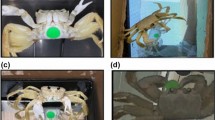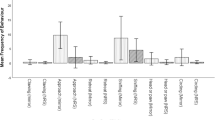Abstract
Mirror self-recognition (MSR), i.e., the ability to recognize oneself in a mirror, is considered a potential index of self-recognition and the foundation of individual development. A wealth of literature on MSR is available for social animals, such as chimpanzees, Asian elephants and dolphins, yet little is known about MSR in solitary mammalian species. We aimed to evaluate whether the giant panda can recognize itself in the mirror, and whether this capacity varies with age. Thirty-four captive giant pandas (F:M = 18:16; juveniles, sub-adults and adults) were subjected to four mirror tests: covered mirror tests, open mirror tests, water mark control tests, and mark tests. The results showed that, though adult, sub-adult and juvenile pandas exposed to mirrors spent similar amounts of time in social mirror-directed behaviors (χ2 = 0.719, P = 0.698), none of them used the mirror to touch the mark on their head, a self-directed behavior suggesting MSR. Individuals of all age groups initially displayed attacking, threatening, foot scraping and backwards walking behaviors when exposed to their self-images in the mirror. Our data indicate that, regardless of age, the giant pandas did not recognize their self-image in the mirror, but instead considered the image to be a conspecific. Our results add to the available information on mirror self-recognition in large mammals, provide new information on a solitary species, and will be useful for enclosure design and captive animal management.





Similar content being viewed by others
References
Allen M, Schwartz BL (2008) Mirror self-recognition in a Gorilla (Gorilla gorilla gorilla). J Integr Biosci 5:19–24
Amsterdam B (1972) Mirror self-image reactions before age two. Dev Psychobiol 5:297–305. doi:10.1002/dev.420050403
Anderson JR (1984) Monkeys with mirrors: some questions for primate psychology. Int J Primatol 5:81–98. doi:10.1007/BF02735149
Anderson JR, Roeder J-J (1989) Responses of capuchin monkeys (Cebus apella) to different conditions of mirror-image stimulation. Primates 30:581–587. doi:10.1007/BF02380884
Brooks-Gunn J, Lewis M (1979) “Why mama and papa?” The development of social labels. Child Dev 50:1203–1206. doi:10.2307/1129349
Calhoun S, Thompson RL (1988) Long-term retention of self-recognition by chimpanzees. Am J Primatol 15:361–365. doi:10.1002/ajp.1350150409
Charlton BD, Zhang Z, Snyder RJ (2009) Vocal cues to identity and relatedness in giant pandas (Ailuropoda melanoleuca). J Acoust Soc Am 126:2721–2732. doi:10.1121/1.3224720
Davies NB, Krebs JR, West SA (2012) An introduction to behavioural ecology (4th edn). Wiley, Oxford, pp 147–178
de Waal FB, Dindo M, Freeman CA, Hall MJ (2005) The monkey in the mirror: hardly a stranger. Proc Natl Acad Sci USA 102:11140–11147. doi:10.1073/pnas.0503935102
Dong W, Zhang J (2011) Evolution of cranial cavities in giant pandas (Ailuropoda melanoleuca, Carnivora, Mammalia). Vertebrata Palasiatica 49:241–252
Dungl E, Schratter D, Huber L (2008) Discrimination of face-like patterns in the giant panda (Ailuropoda melanoleuca). J Comp Psychol 122:335–343. doi:10.1037/0735-7036.122.4.335
Epstein R, Lanza RP, Skinner BF (1981) Self-awareness in the pigeon. Science 212:695–696. doi:10.1126/science.212.4495.695
Gallup GG (1970) Chimpanzees: self-recognition. Science 167:86–87. doi:10.1126/science.167.3914.86
Gallup GG (1977) Absence of self-recognition in a monkey (Macaca fascicularis) following prolonged exposure to a mirror. Dev Psychobiol 10:281–284. doi:10.1002/dev.420100312
Gallup GG (1994) Self-recognition: research strategies and experimental design. In: Parker ST, Mitchell RW, Boccia ML (eds) Self-awareness in animals and humans: developmental perspectives. Cambridge University Press, Cambridge, pp 35–50
Gallup GG, Suarez SD (1991) Social responding to mirrors in rhesus monkeys (Macaca mulatta): effects of temporary mirror removal. J Comp Psychol 105:376–379. doi:10.1037/0735-7036.105.4.376
Gittleman JL (1986) Carnivore brain size, behavioral ecology, and phylogeny. J Mammal 67:23–36. doi:10.2307/1380998
Heth G, Todrank J, Johnston RE (1999) Similarity in the qualities of individual odors among kin and species in Turkish (Mesocricetus brandti) and golden (Mesocricetus auratus) hamsters. J Comp Psychol 113:321–326. doi:10.1037/0735-7036.113.3.321
Heyes CM (1994) Reflections on self-recognition in primates. Anim Behav 47:909–919. doi:10.1006/anbe.1994.1123
Heyes CM (1995) Self-recognition in primates: further reflections create a hall of mirrors. Anim Behav 50:1533–1542. doi:10.1016/0003-3472(95)80009-3
Ji H, Guo D, Tao S (1996) Habituation and recovery of visual attention in normal infants. Chin Behav Med Sci 5:5–6 (In Chinese with English abstract)
Keen HA, Nelson OL, Robbins CT, Evans M, Shepherdson DJ, Newberry RC (2014) Validation of a novel cognitive bias task based on difference in quantity of reinforcement for assessing environmental enrichment. Anim Cogn 17:529–541. doi:10.1007/s10071-013-0684-1
Kelling AS, Snyder RJ, Marr MJ, Bloomsmith MA, Gardner W, Maple TL (2006) Color vision in the giant panda (Ailuropoda melanoleuca). Learn Behav 34:154–161. doi:10.3758/BF03193191
Ledbetter DH, Basen JA (1982) Failure to demonstrate self-recognition in gorillas. Am J Primatol 2:307–310. doi:10.1002/ajp.1350020309
Lefebvre L, Reader SM, Sol D (2004) Brains, innovations and evolution in birds and primates. Brain Behav Evol 63:233–246. doi:10.1159/000076784
Lethmate J, Dücker G (1973) Untersuchungen zum selbsterkennen im spiegel bei orangutans und einigen anderen affenarten. Z Tierpsychol 33:248–269
Lin AC, Bard KA, Anderson JR (1992) Development of self-recognition in chimpanzees (Pan troglodytes). J Comp Psychol 106:120–127. doi:10.1037//0735-7036.106.2.120
Liu L, Yang LZ (2009) Research progress in self-face recognition. J Liaoning Normal Univ (Social Science Edition) 32:52–55. doi:10.3969/j.issn.1000-1751.2009.03.014 (In Chinese with English abstract)
Liu D, Yuan H, Tian H, Wei RP, Zhang GQ, Sun LX, Wang LW, Sun RY (2006) Do anogenital gland secretions of giant panda code for their sexual ability? Chin Sci Bull 51:1986–1995. doi:10.1007/s11434-006-2088-y
Mans L, Cicchetti D, Sroufe LA (1978) Mirror reactions of down’s syndrome infants and toddlers: cognitive underpinnings of self-recognition. Child Dev 49:1247–1250. doi:10.1111/j.1467-8624.1978.tb04100.x
Martin P, Bateson P (1986) Measuring behaviour. Cambridge University Press, Cambridge
Mitchell RW, Anderson JR (1993) Discrimination learning of scratching, but failure to obtain imitation and self-recognition in a long-tailed macaque. Primates 34:301–309. doi:10.1007/BF02382625
Patterson FG, Cohn RH (2006) Self-recognition and self-awareness in lowland gorillas. In: Parker ST, Mitchell RW, Boccia ML (eds) Self-awareness in animals and humans: Developmental perspectives. Cambridge University Press, Cambridge, pp 273–290
Plotnik JM, De Waal FB, Reiss D (2006) Self-recognition in an Asian elephant. Proc Natl Acad Sci USA 103:17053–17057. doi:10.1073/pnas.0608062103
Povinelli DJ, Rulf AB, Landau KR, Bierschwale DT (1993) Self-recognition in chimpanzees (Pan troglodytes): distribution, ontogeny, and patterns of emergence. J Comp Psychol 107:347–372. doi:10.1037/0735-7036.107.4.347
Prior H, Schwarz A, Güntürkün O (2008) Mirror-induced behavior in the magpie (Pica pica): evidence of self-recognition. PLoS Biol 6:1642–1650. doi:10.1371/journal.pbio.0060202
Reiss D, Marino L (2001) Mirror self-recognition in the bottlenose dolphin: a case of cognitive convergence. Proc Natl Acad Sci USA 98:5937–5942. doi:10.1073/pnas.101086398
Roma PG, Silberberg A, Huntsberry ME, Christensen CJ, Ruggiero AM, Suomi SJ (2007) Mark tests for mirror self-recognition in capuchin monkeys (Cebus apella) trained to touch marks. Am J Primatol 69:989–1000. doi:10.1002/ajp.20404
Schaller GB, Hu J, Pan W, Zhu J (1985) The giant pandas of wolong. University of Chicago press, Chicago
Shaffer VA, Renner MJ (2000) Black-and-white colobus monkeys (Colobus guereza) do not show mirror self-recognition. Int J Comp Psychol 13:154–160
Shang Y (2005) Animal habituation behavior. Bull Biol 40:9–11. doi:10.3969/j.issn.0006-3193.2005.10.004
Suárez SD, Gallup GG (1981) Self-recognition in chimpanzees and orangutans, but not gorillas. J Hum Evol 10:175–188
Suddendorf T, Butler DL (2013) The nature of visual self-recognition. Trends Cognit Sci 17:121–127. doi:10.1016/j.tics.2013.01.004
Swaisgood RR, Lindburg DG, Zhou XP (1999) Giant pandas discriminate individual differences in conspecific scent. Anim Behav 57:1045–1053. doi:10.1006/anbe.1998.1070
Swartz KB, Evans S (1991) Not all chimpanzees (Pan troglodytes) show self-recognition. Primates 32:483–496. doi:10.1007/BF02381939
Toda K, Watanabe S (2008) Discrimination of moving video images of self by pigeons (Columba livia). Anim Cogn 11:699–705. doi:10.1007/s10071-008-0161-4
Wang J (2010) What are animal friends thinking. Hubei Children Press, Hubei (In Chinese)
Xie J, Pirlot P, Jiao S, Wang Y, Zhang G, Zhang S (1984) Quantitative morphology of the giant panda brain in comparison with those of the American bear and the Raccoon. J Beijing Second Med College 2:97–101 (In Chinese with English abstract)
Xu M, Wang ZP, Liu DZ, Wei RP, Zhang GQ, Zhang HM, Zhou XP, Li DS (2012) Cross-modal signaling in giant pandas. Chin Sci Bull 56:1–5. doi:10.1007/s11434-011-4843-y
Yang H (2005) On the uniqueness of self-face recognition. Psychol Sci 28:1517–1519. doi:10.3969/j.issn.1671-6981.2007.05.026
Yuan H, Liu DZ, Sun LX, Wei RP, Zhang GQ, Sun RY (2004) Anogenital gland secretions code for sex and age in the giant panda, Ailuropoda melanoleuca. Can J Zool 82:1596–1604. doi:10.1139/z04-144
Zhang J-X, Liu DZ, Sun LX, Wei RP, Zhang GQ, Wu HL, Zhang HM, Zhao C (2008) Potential chemosignals in the anogenital gland secretion of giant pandas, Ailuropoda melanoleuca, associated with sex and individual identity. J Chem Ecol 34:398–407. doi:10.1007/s10886-008-9441-3
Acknowledgments
We thank staff at the China Conservation and Research Center for the Giant Panda for their assistance in data collection and animal management. This work was supported by grants from the Natural Science Foundation of China NSFC (Grant No. 31172097, 31472009), the National Key Technology R & D Program of the Ministry of Science and Technology of China (Grant No. 2012BAC01B06), and the International Collaborative Project on the Conservation for the Giant Panda to D Liu (Grant No. Beijing-2010-02) and R Wei (Grant No. SD0630).
Conflict of interest
The authors declare that they have no conflict of interest.
Ethical standards
The experiments comply with the current laws of the People’s Republic of China.
Author information
Authors and Affiliations
Corresponding author
Rights and permissions
About this article
Cite this article
Ma, X., Jin, Y., Luo, B. et al. Giant pandas failed to show mirror self-recognition. Anim Cogn 18, 713–721 (2015). https://doi.org/10.1007/s10071-015-0838-4
Received:
Revised:
Accepted:
Published:
Issue Date:
DOI: https://doi.org/10.1007/s10071-015-0838-4




